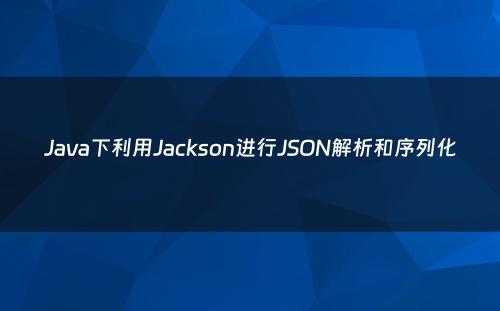网站首页 > java教程 正文
Java下常见的Json类库有Gson、JSON-lib和Jackson等,Jackson相对来说比较高效,在项目中主要使用Jackson进行JSON和Java对象转换,下面给出一些Jackson的JSON操作方法。
一、准备工作
Jackson有1.x系列和2.x系列,2.x系列有3个jar包需要下载:

jackson-core-2.2.3.jar(核心jar包)
jackson-annotations-2.2.3.jar(该包提供Json注解支持)
jackson-databind-2.2.3.jar
maven依赖就够了
<dependency> <groupId>com.fasterxml.jackson.core</groupId> <artifactId>jackson-databind</artifactId> <version>2.5.3</version> </dependency>
import java.util.Date;
/**
* JSON序列化和反序列化使用的User类
*/
public class User {
private String name;
private Integer age;
private Date birthday;
private String email;
public String getName() {
return name;
}
public void setName(String name) {
this.name = name;
}
public Integer getAge() {
return age;
}
public void setAge(Integer age) {
this.age = age;
}
public Date getBirthday() {
return birthday;
}
public void setBirthday(Date birthday) {
this.birthday = birthday;
}
public String getEmail() {
return email;
}
public void setEmail(String email) {
this.email = email;
}
@Override
public String toString() {
return "User{" +
"name='" + name + '\'' +
", age=" + age +
", birthday=" + birthday +
", email='" + email + '\'' +
'}';
}
}
二、JAVA对象转JSON[JSON序列化]
import java.io.IOException;
import java.text.ParseException;
import java.text.SimpleDateFormat;
import java.util.ArrayList;
import java.util.List;
import com.fasterxml.jackson.databind.ObjectMapper;
public class JacksonDemo {
public static void main(String[] args) throws ParseException, IOException {
User user = new User();
user.setName("zhangsan");
user.setEmail("zhangsan@163.com");
user.setAge(20);
SimpleDateFormat dateformat = new SimpleDateFormat("yyyy-MM-dd");
user.setBirthday(dateformat.parse("1996-10-01"));
/**
* ObjectMapper是JSON操作的核心,Jackson的所有JSON操作都是在ObjectMapper中实现。
* ObjectMapper有多个JSON序列化的方法,可以把JSON字符串保存File、OutputStream等不同的介质中。
* writeValue(File arg0, Object arg1)把arg1转成json序列,并保存到arg0文件中。
* writeValue(OutputStream arg0, Object arg1)把arg1转成json序列,并保存到arg0输出流中。
* writeValueAsBytes(Object arg0)把arg0转成json序列,并把结果输出成字节数组。
* writeValueAsString(Object arg0)把arg0转成json序列,并把结果输出成字符串。
*/
ObjectMapper mapper = new ObjectMapper();
//User类转JSON
//输出结果:{"name":"zhangsan","age":20,"birthday":844099200000,"email":"zhangsan@163.com"}
String json = mapper.writeValueAsString(user);
System.out.println(json);
//Java集合转JSON
//输出结果:[{"name":"zhangsan","age":20,"birthday":844099200000,"email":"zhangsan@163.com"}]
List<User> users = new ArrayList<User>();
users.add(user);
String jsonlist = mapper.writeValueAsString(users);
System.out.println(jsonlist);
}
}
三、JSON转Java类[JSON反序列化]
public class JacksonDemo {
public static void main(String[] args) throws ParseException, IOException {
String json = "{\"name\":\"zhangsan\",\"age\":20,\"birthday\":844099200000,\"email\":\"zhangsan@163.com\"}";
/**
* ObjectMapper支持从byte[]、File、InputStream、字符串等数据的JSON反序列化。
*/
ObjectMapper mapper = new ObjectMapper();
User user = mapper.readValue(json, User.class);
System.out.println(user);
}
}
User{name='zhangsan', age=20, birthday=Tue Oct 01 00:00:00 CST 1996, email='zhangsan@163.com'}
public class JacksonDemo {
public static ObjectMapper mapper = new ObjectMapper();
public static void main(String[] args) throws ParseException, IOException {
String json = "[{\"name\":\"zhangsan\",\"age\":20,\"birthday\":844099200000,\"email\":\"zhangsan@163.com\"}]";
List<User> beanList = mapper.readValue(json, new TypeReference<List<User>>() {});
System.out.println(beanList);
}
}
[User{name='zhangsan', age=20, birthday=Tue Oct 01 00:00:00 CST 1996, email='zhangsan@163.com'}]
四、JSON注解
Jackson提供了一系列注解,方便对JSON序列化和反序列化进行控制,下面介绍一些常用的注解。
@JsonIgnore 此注解用于属性上,作用是进行JSON操作时忽略该属性。
@JsonFormat 此注解用于属性上,作用是把Date类型直接转化为想要的格式,如@JsonFormat(pattern = "yyyy-MM-dd HH-mm-ss")。
@JsonProperty 此注解用于属性上,作用是把该属性的名称序列化为另外一个名称,如把trueName属性序列化为name,@JsonProperty("name")。
import com.fasterxml.jackson.annotation.JsonFormat;
import com.fasterxml.jackson.annotation.JsonIgnore;
import com.fasterxml.jackson.annotation.JsonProperty;
import java.util.Date;
/**
* JSON序列化和反序列化使用的User类
*/
public class User {
private String name;
//不JSON序列化年龄属性
@JsonIgnore
private Integer age;
//格式化日期属性
@JsonFormat(pattern = "yyyy年MM月dd日")
private Date birthday;
//序列化email属性为mail
@JsonProperty("my_email")
private String email;
public String getName() {
return name;
}
public void setName(String name) {
this.name = name;
}
public Integer getAge() {
return age;
}
public void setAge(Integer age) {
this.age = age;
}
public Date getBirthday() {
return birthday;
}
public void setBirthday(Date birthday) {
this.birthday = birthday;
}
public String getEmail() {
return email;
}
public void setEmail(String email) {
this.email = email;
}
@Override
public String toString() {
return "User{" +
"name='" + name + '\'' +
", age=" + age +
", birthday=" + birthday +
", email='" + email + '\'' +
'}';
}
}
import com.fasterxml.jackson.databind.ObjectMapper;
import java.io.IOException;
import java.text.ParseException;
import java.text.SimpleDateFormat;
public class JacksonDemo {
public static void main(String[] args) throws ParseException, IOException {
User user = new User();
user.setName("zhangsan");
user.setEmail("zhangsan@163.com");
user.setAge(20);
SimpleDateFormat dateformat = new SimpleDateFormat("yyyy-MM-dd");
user.setBirthday(dateformat.parse("1996-10-01"));
ObjectMapper mapper = new ObjectMapper();
String json = mapper.writeValueAsString(user);
System.out.println(json);
}
}
{"name":"zhangsan","birthday":"1996年09月30日","my_email":"zhangsan@163.com"}
Jackson常用注解详解:@JsonProperty
最常见的使用方式之一就是改变某个成员属性所使用的JSON名称,例如:
public class Name {
@JsonProperty("firstName")
public String _first_name;
}
将会生成如下所示的JSON数据结果:
{ "firstName" : "Bob" }
而不是:
{ "_first_name" : "Bob"}
忽略属性时使用的注解: @JsonIgnore
有时POJO包括了一些你不希望输出的属性,在这种情况下,你可以进行如下操作:
public class Value {
public int value;
@JsonIgnore
public int internalValue;
}
这时得到的JSON数据结果如下:
{ "value" : 42 }
或者,你可能忽略掉某些从JSON数据中得到的属性,如果是这样,你可以使用:
@JsonIgnoreProperties({ "extra", "uselessValue" })
public class Value {
public int value;
}
这样就能够处理像如下所示的JSON数据:
{
"value" : 42,
"extra" : "fluffy",
"uselessValue" : -13
}
最后,你甚至能简单地忽略掉从JSON(由于在应用中没有完全匹配的POJO)中获得的所有“多余的”属性。你可以通过添加如下代码完成这个操作:
@JsonIgnoreProperties(ignoreUnknown=true)
public class PojoWithAny {
public int value;
}
选择更多/更少指定类型时使用的注解
在有些情况下,Jackson在读入或输出一个成员属性时,所选用的类型可能并不是你想要的:
当读取(反序列化)时,声明的类型可能是一个基本类型,但是你确切地知道应该使用的实现类型(ps:也就说,我们需要反序列化后生成的对象是实现类型的)
当输出(序列化)时,Jackson默认使用的是给定的运行时类型;但是你可能不想输出那个类型的所有信息,而仅仅是它的父类型所囊括的信息。
在这些应用场景,你可以使用如下的注解进行处理:
public class ValueContainer {
// 虽然代码中使用的类型是 Value, 但我们希望读取到的JSON 之后得到的对象的类型是 ValueImpl
@JsonDeserialize(as=ValueImpl.class)
public Value value;
// 虽然运行时的类型可能是 AdvancedType , 但是我们确实想序列化
// 成为 BasicType ; 有两种处理方式:
@JsonSerialize(as=BasicType.class)
// 或者我们可以这样: @JsonSerialize(typing=Typing.STATIC)
public BasicType another;
}
以上就是我的分享,感谢各位大佬们耐心看完文章,觉得有收获的朋友们可以点个关注收藏转发
猜你喜欢
- 2024-10-10 简单的对象转换方法类分享(对象转化为字符串的几种方式)
- 2024-10-10 为什么 JSON 不适合作为配置语言?
- 2024-10-10 JSON 对象的这些操作和使用场景你知道多少?
- 2024-10-10 第27天|Java入门有野,json操作(java的json解析几种方法)
- 2024-10-10 如何使用springmvc返回json格式的数据?
- 2024-10-10 springboot从小白到大神-007处理Json数据进阶
- 2024-10-10 Fastjson2如何进行JSON的解析和对象序列化?
- 2024-10-10 Java笔试题目分享(2)知识点总结——Json对象
- 2024-10-10 面试官问,你知道http请求怎么在你的项目中变成Java对象吗?
- 2024-10-10 Spring Boot 中使用FastJSON来替换默认的JSON数据序列方式?
欢迎 你 发表评论:
- 12-25iso文件重装系统win7步骤(iso文件如何重装)
- 12-25新路由3固件(新3路由器固件)
- 12-25手机vsd文件查看器(手机查看vsd文件软件)
- 12-25子路由器如何设置才可以上网
- 12-25最新韩剧排行榜前十名(2021最新韩剧排行榜前十名)
- 12-25sgi系统安装工具(系统安装工具怎样安装系统)
- 12-25cad2016激活码免费使用教程(cad 2016 激活码)
- 12-25小米wifi管理器(小米wifi管理软件)
- 最近发表
- 标签列表
-
- java反编译工具 (77)
- java反射 (57)
- java接口 (61)
- java随机数 (63)
- java7下载 (59)
- java数据结构 (61)
- java 三目运算符 (65)
- java对象转map (63)
- Java继承 (69)
- java字符串替换 (60)
- 快速排序java (59)
- java并发编程 (58)
- java api文档 (60)
- centos安装java (57)
- java调用webservice接口 (61)
- java深拷贝 (61)
- 工厂模式java (59)
- java代理模式 (59)
- java.lang (57)
- java连接mysql数据库 (67)
- java重载 (68)
- java 循环语句 (66)
- java反序列化 (58)
- java时间函数 (60)
- java是值传递还是引用传递 (62)

本文暂时没有评论,来添加一个吧(●'◡'●)